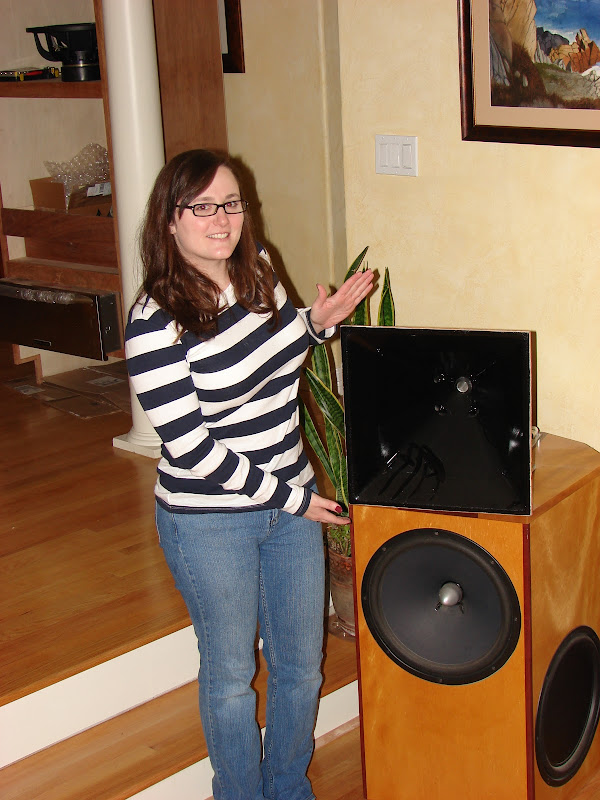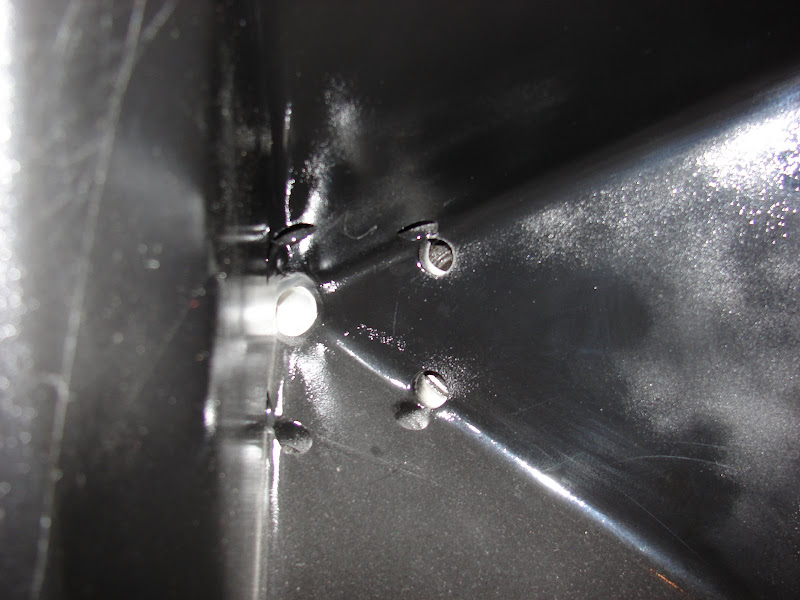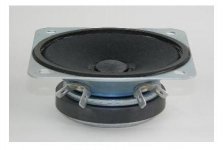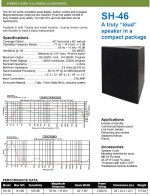I have a set of Lambda Unity drivers and when I visited William Cowan earlier in the year, he measured the T/S of all 8 and they came out close to, but not the same as the JC5 published specs.I've been messing with Unity horns for close to three years now, and I've managed to purchase a pile of midrange drivers that work on Unity horns. I have the Misco drivers which I believe were used in the Lambda Unity horns, as well as a newer driver from Misco which is as good or better.
One interesting alternative is the Tang Band W4-1805S. Tang Band makes a lot of great drivers, but only TWO of them will work on a Unity horn. The reason that all the others won't work is that their cones are too heavy, which drives down the FS too low, and the QES is too high. This particular woofer is an exception. It has the right specs for a Unity horn, AND it has an underhung motor with very low distortion. I haven't measured it's distortion yet, but it's audibly cleaner than the Misco.
The TB looks interesting. I'll keep it on file to experiment once the current designs are done.
While Danley's choice of a midrange with an Fb of 500hz is a good one, I *personally* prefer one with a higher Fb. That's one of the reasons I like the TangBand W2-854SH and the Misco KC5. When you use a woofer with a higher FB, you can cross the compression driver over at a higher frequency, which reduces distortion. The downside is that you have to run the woofers higher, but it's a reasonable tradeoff.
Anyways, Parts Express has some woofers on sale for about four bucks each in quantity that look quite promising:
Parts-Express.com:*JAMO 20470 4-1/2" Sealed Back Midrange | JAMO 20470 4-1/2" Sealed Back Midrange driver speaker midrange
Anyways, Parts Express has some woofers on sale for about four bucks each in quantity that look quite promising:
Parts-Express.com:*JAMO 20470 4-1/2" Sealed Back Midrange | JAMO 20470 4-1/2" Sealed Back Midrange driver speaker midrange
An externally hosted image should be here but it was not working when we last tested it.
Last edited:
The only problem is we don't know what the T/S parameters are on the JAMO 4 1/2" sealed back mid.
The only problem is we don't know what the T/S parameters are on the JAMO 4 1/2" sealed back mid.
For the most part, all that matters is the Fb (which is 700hz.)
Admittedly, the bandwidth will be affected by the qms and the qes, but for the price, it's worth a shot.
I've messed around with a number of unity midranges over the past few years. I have what I believe are the ones from the old Lambda Unity horn, as well as good candidates from Tang Band and JBL. After listening to various models, I noticed that I prefer the Tangband over the "real" woofers. I've done distortion measurements on the "real" woofers, and the performance is rather average. Which isn't a big shock - it's an inexpensive woofer with no shorting rings, a limited xmax, and a fragile paper cone.
So this isn't a knock against the Danley design - there aren't many woofers that can take a large amount of power, and have parameters suitable for a unity horn. This thread illustrates that.
Anyways, TangBand just released a new model that's a good candidate.
Parts-Express.com: Tang Band W3-1401SD 3" Neodymium Full Range Driver | Tang Band W3-1401D 3" driver Full Range Driver full range tb speakers neodymium driver line array point source midrange home theater computer speaker center channel set tube ampl
An externally hosted image should be here but it was not working when we last tested it.
The (fs/qes) is 197. Ideally we need it to be about 500hz. In my experience the FS on TangBand woofers tends to be quite a bit higher than published, which makes this driver attractive.
For the most part, all that matters is the Fb (which is 700hz.)
Admittedly, the bandwidth will be affected by the qms and the qes, but for the price, it's worth a shot.
I would disagree with that. There have been a number of sealed back mids I've gone through that did not work because the Qes was too high, Mmd was too high, or Cms was too low even through the Fs was between 400Hz and 630Hz. There is too much interaction between all the parts of a Unity to just chuck any sealed back mid into the mix. I don't even bother trying a woofer unless I've modeled it in Akabak first. You can't just look at Fs and say it will be okay. I tried a set of Curtis Mathis sealed back midranges and they didn't work for the reason I wrote about above. The T/S parameters caused too much phase rotation through the band pass. The crossover made it even worse. I wish it was as easy as Fs, but its not. I'm afraid you'd be setting yourself up for failure if you don't consider the whole picture when selecting a midrange for the Unity.
FWIW I picked up a couple of the TB W2-880SL drivers, and they're pretty cool. They look to be the same W2 frame/motor as on the 852 paper cone (although they're metal, and I thought the 852 was plastic) but with an Al/Mg cone which is similar to the one on the Aura whisper but a bit flatter. Published specs look to be very interesting for a Unity mid - Fs 160 Qes .26, Fs/Qes=615 . I don't have a measurement setup at the moment to confirm, but hopefully should have one in the not too distant future.
The slight irony is that I'm actually planning to use these as the 'tweeters' in one version of a quasi-Unity project. This is the "built into the room corner" idea I mentioned on the Unity/Summa thread. I do have a 3-way idea variant using them as mids as well, but I think construction would be significantly more complicated with little benefit. My perception of cost/benefit will obviously change if the top end on the TB's doesn't meet expectations.
I also have the Aura Whispers and a pair of the Fountek FR88-ex which all will be considered for the 'tweeter' role, although I think the TB is looking like the best option on paper at the moment. I'm thinking an xover to the mids somewhere in the 500-800 range dependent on which driver gets used. The scant 1mm xmax of the TB might suggest something closer to 800, while the other two should be OK down to 500 or lower with their 3mm xmax.
Another Unity project I stumbled upon recently was a link to something William Cowan has on his site - a 2-way unity apparently somewhat similar to the SPL Runt; He's using the B&C 8NDL51: Future Projects
This is a reminder (to me at least) that the 'mids' in a Unity don't really need to be a classic bandpass to work, particularly if you're willing to sacrifice efficiency. With the Runt and apparently in Williams project the mids cover way too much bandwidth to be a traditional tuned 4th-order bandpass which typically is limited to a couple octaves - good for covering 300-1.2k like in my U15's, but not for the Runt. Presumably in these designs the entry ports are serving as simple ducts for the direct radiation over much of their bandwidth and the resonant characteristics are secondary. I have had similar thoughts for my corner project; covering the drivers in some fashion would seem to be important to reduce reflections off the cone, but I don't think I need to rely on the bandpass tuning to make the design work (I guess we'll see). My thought on this for my project was more of a metal grille cover rather than ports/ducts, but I haven't tried modeling or experimenting with anything yet.
BTW - anyone think that a "General Unity/Synergy Discussion" topic would be a good idea? Discussion of these things is spread all over the place. Looking at the Tapped Horn thread, it seemed to be pretty successful at consolidating things into one spot, even though there were many sub-discussions.
The slight irony is that I'm actually planning to use these as the 'tweeters' in one version of a quasi-Unity project. This is the "built into the room corner" idea I mentioned on the Unity/Summa thread. I do have a 3-way idea variant using them as mids as well, but I think construction would be significantly more complicated with little benefit. My perception of cost/benefit will obviously change if the top end on the TB's doesn't meet expectations.
I also have the Aura Whispers and a pair of the Fountek FR88-ex which all will be considered for the 'tweeter' role, although I think the TB is looking like the best option on paper at the moment. I'm thinking an xover to the mids somewhere in the 500-800 range dependent on which driver gets used. The scant 1mm xmax of the TB might suggest something closer to 800, while the other two should be OK down to 500 or lower with their 3mm xmax.
Another Unity project I stumbled upon recently was a link to something William Cowan has on his site - a 2-way unity apparently somewhat similar to the SPL Runt; He's using the B&C 8NDL51: Future Projects
This is a reminder (to me at least) that the 'mids' in a Unity don't really need to be a classic bandpass to work, particularly if you're willing to sacrifice efficiency. With the Runt and apparently in Williams project the mids cover way too much bandwidth to be a traditional tuned 4th-order bandpass which typically is limited to a couple octaves - good for covering 300-1.2k like in my U15's, but not for the Runt. Presumably in these designs the entry ports are serving as simple ducts for the direct radiation over much of their bandwidth and the resonant characteristics are secondary. I have had similar thoughts for my corner project; covering the drivers in some fashion would seem to be important to reduce reflections off the cone, but I don't think I need to rely on the bandpass tuning to make the design work (I guess we'll see). My thought on this for my project was more of a metal grille cover rather than ports/ducts, but I haven't tried modeling or experimenting with anything yet.
BTW - anyone think that a "General Unity/Synergy Discussion" topic would be a good idea? Discussion of these things is spread all over the place. Looking at the Tapped Horn thread, it seemed to be pretty successful at consolidating things into one spot, even though there were many sub-discussions.
Here's the spec sheet for the aforementioned midrange. There's a type on the name in the last post.
http://www.tb-speaker.com/detail/1230_04/w2-800sl.htm

Chicks dig Unity horns

Note that the holes enter at the apex of two walls

In my Unity horns, there's no way to do this
If you've followed my Unity projects, you may have noticed that I use waveguides with ellipitical mouths, and Danley uses horns with square mouths. Because of my choice, the holes on my midranges terminate on a flat surface. Because of Danley's choice, the holes on his midranges terminate at the apex of two walls.
The reason I bring this up is because there's no such thing as a simple duct. As soon as you stick a barrier in front of the midrange, you've created a coupling chamber. The only way of getting around that fact is if you remove the barrier.
But when you remove the barrier, you just ruined your point source.
Basically that's the whole reason the imaging and the articulation of the Unity horn is so re-donk-u-lous, our midranges and our tweeter are all radiating from a very small point in space.
So I'd really discourage you from using direct radiators; that takes away the magic.
Now there are a zillion things you can do to improve the bandpass response of the midranges:
A lot of this stuff seems like too much work, but you really have to dedicate some effort into those ports. If you use a conventional port it would be quite long and wide. With a compression ratio of four-to-one, an eight inch piston should have a 2" port!
So it's a ton of work, but the only way to get the Unity to work is to sort out those ports. You can't just treat it like a duct and get good results.
http://www.tb-speaker.com/detail/1230_04/w2-800sl.htm
This is a reminder (to me at least) that the 'mids' in a Unity don't really need to be a classic bandpass to work, particularly if you're willing to sacrifice efficiency. With the Runt and apparently in Williams project the mids cover way too much bandwidth to be a traditional tuned 4th-order bandpass which typically is limited to a couple octaves - good for covering 300-1.2k like in my U15's, but not for the Runt. Presumably in these designs the entry ports are serving as simple ducts for the direct radiation over much of their bandwidth and the resonant characteristics are secondary. I have had similar thoughts for my corner project; covering the drivers in some fashion would seem to be important to reduce reflections off the cone, but I don't think I need to rely on the bandpass tuning to make the design work (I guess we'll see). My thought on this for my project was more of a metal grille cover rather than ports/ducts, but I haven't tried modeling or experimenting with anything yet.
Chicks dig Unity horns
Note that the holes enter at the apex of two walls

In my Unity horns, there's no way to do this
If you've followed my Unity projects, you may have noticed that I use waveguides with ellipitical mouths, and Danley uses horns with square mouths. Because of my choice, the holes on my midranges terminate on a flat surface. Because of Danley's choice, the holes on his midranges terminate at the apex of two walls.
The reason I bring this up is because there's no such thing as a simple duct. As soon as you stick a barrier in front of the midrange, you've created a coupling chamber. The only way of getting around that fact is if you remove the barrier.
But when you remove the barrier, you just ruined your point source.
Basically that's the whole reason the imaging and the articulation of the Unity horn is so re-donk-u-lous, our midranges and our tweeter are all radiating from a very small point in space.
So I'd really discourage you from using direct radiators; that takes away the magic.
Now there are a zillion things you can do to improve the bandpass response of the midranges:
- I believe Danley puts the midrange holes at the apex of two angles so that the wall of the horn extends the port. If Danley had terminated the ports on a flat surface, the ports would probably be twice as long.
- A small woofer can use a smaller port. My use of 2" drivers allows me to mount my midranges closer than Danley can. It also allows me to get away with a port size that's completely impractical with a 5" driver. The downside is that I have issues with power handling. Then again, I am only using two. And the voice coils on mine are just 3/4". Yours are 1".
- The use of a frustrum instead of a port allows you to get away with a smaller hole on the surface of the horn. (check out the patent.)
- If you wanted to use an eight, you'd probably have to go full monty and make a phase plug. I have personally used four inch woofers with a Unity horn, and found that a crude phase plug extended the high frequency response.
A lot of this stuff seems like too much work, but you really have to dedicate some effort into those ports. If you use a conventional port it would be quite long and wide. With a compression ratio of four-to-one, an eight inch piston should have a 2" port!
So it's a ton of work, but the only way to get the Unity to work is to sort out those ports. You can't just treat it like a duct and get good results.
I would disagree with that. There have been a number of sealed back mids I've gone through that did not work because the Qes was too high, Mmd was too high, or Cms was too low even through the Fs was between 400Hz and 630Hz. There is too much interaction between all the parts of a Unity to just chuck any sealed back mid into the mix. I don't even bother trying a woofer unless I've modeled it in Akabak first. You can't just look at Fs and say it will be okay. I tried a set of Curtis Mathis sealed back midranges and they didn't work for the reason I wrote about above. The T/S parameters caused too much phase rotation through the band pass. The crossover made it even worse. I wish it was as easy as Fs, but its not. I'm afraid you'd be setting yourself up for failure if you don't consider the whole picture when selecting a midrange for the Unity.
I didn't say that it was the Fs that matters, I said it was the Fb 🙂
And Fb is dependent on Qes.
So I think we agree.
Here is another one for you guys.
Def_Driver 'MidDriver' |Misco JN3C-4A 3" mid
Sd=28.27cm2
Bl=3.09Tm
Cms=7.90E-04m/N
Rms=0.42Ns/m
fs=103.1Hz
Le=0.14mH
Re=3.4ohm
ExpoLe=0.618
An externally hosted image should be here but it was not working when we last tested it.
Def_Driver 'MidDriver' |Misco JN3C-4A 3" mid
Sd=28.27cm2
Bl=3.09Tm
Cms=7.90E-04m/N
Rms=0.42Ns/m
fs=103.1Hz
Le=0.14mH
Re=3.4ohm
ExpoLe=0.618
I didn't say that it was the Fs that matters, I said it was the Fb 🙂
And Fb is dependent on Qes.
So I think we agree.
True, I see what you are saying now. BTW, I think I might have unearthed a real gem. Drop me a measage or e-mail. We need to talk. See teaser picture.
Rgs, JLH
Attachments
The T/S parameters for the above 3" sealed back midrange. Even with the high Fb, it is solid down to 420Hz and it's high end is only limited to how close you can get it to the compression driver. With a slot port instead of the typical round port, you should be able to place it right at the compression driver exit on the waveguide.
Sd=29.22cm2
Bl=1.37Tm
Cms=6.87E-05m/N
Rms=0.33Ns/m
fs=1275Hz
Le=0.57mH
Re=7.38ohm
ExpoLe=0.618
Sd=29.22cm2
Bl=1.37Tm
Cms=6.87E-05m/N
Rms=0.33Ns/m
fs=1275Hz
Le=0.57mH
Re=7.38ohm
ExpoLe=0.618
Before using cheapo sealed back midranges, could one use cheapo phenolic compression drivers for paging horns instead? Visaton use one in a serious design (not highend of course).
I suppose you could try to use phenolic compression drivers. However, it would present several problems. The first problem is how are you going to get the 1” exit to interface with the entrance ports into the waveguide? The second and most serious problem is the complete lack of T/S parameters. Without simulation software and a solid set of parameters you will be shooting in the dark. Due to the very specific set of requirements to make a Unity/Synergy work trial and error is no way to go. On the other hand, it is these very specific requirements that lend their selves to inexpensive sealed back drivers. These drivers have exactly the needed parameters to work well in Unity/Synergy horns. In this case price and performance are not indicators of each other.
Rgs, JLH
Rgs, JLH
For the compression driver: I meant closing the front, removing the back and use it reversed, but...
Isn't a bandpass something that needs some excursion? This one has 3 mm, but $$$.
404 - File or directory not found.
Maybe there are plenty of similar drivers in the car sector.
I calculated the Qes of the Ciare: 2.2
So the EBP is 227.
The motor of the 8 Ohm home version is much weaker. As Bl is the same they seem to have used the same magnet and the same number of windings, just with thinner wire, so this version can be ruled out.
Isn't a bandpass something that needs some excursion? This one has 3 mm, but $$$.
404 - File or directory not found.
Maybe there are plenty of similar drivers in the car sector.
I calculated the Qes of the Ciare: 2.2
So the EBP is 227.
The motor of the 8 Ohm home version is much weaker. As Bl is the same they seem to have used the same magnet and the same number of windings, just with thinner wire, so this version can be ruled out.
Why go through all this trouble when you can simply bolt on a $6 sealed back midrange? In the case of this 3" sealed midrange, the low frequency limit will be above 400Hz, which doesn't require much if any Xmax. Danley uses four of the Celestion TF0410MR 4" sealed back midranges on several of the newer Synergy horns to the tune of 141dB with 2800 Watts.
Attachments
I have one driver in my test horn awaiting my PE order. Does unity horns exhibit the double cone area = +3db theory?
On another note, I find it difficult to couple larger (6"+) drivers to the horn properly. I've had good results (6-15db gain) with a $2, 2" x 3.5" driver.
On another note, I find it difficult to couple larger (6"+) drivers to the horn properly. I've had good results (6-15db gain) with a $2, 2" x 3.5" driver.
- Home
- Loudspeakers
- Multi-Way
- Suitable midrange cone, for bandpass mid in Unity horn


